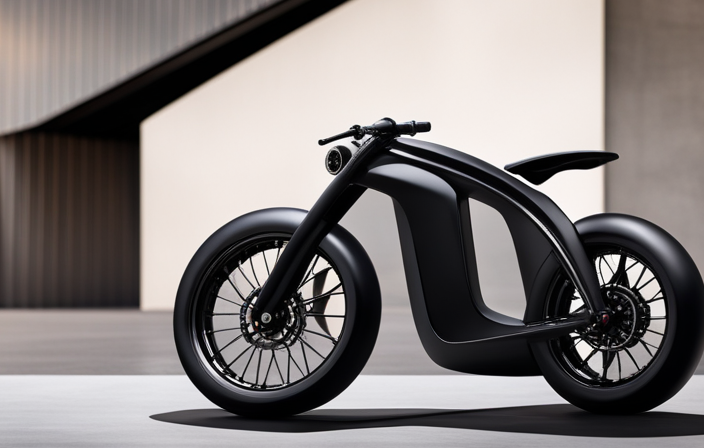Were you aware that the typical lifespan of a battery for an electric bike spans approximately 3 to 5 years?
As a passionate electric bike enthusiast, I’ve always been curious about how long these batteries can really last.
In this article, we’ll dive into the different types of electric bike batteries, the factors that affect their lifespan, and how you can extend their longevity.
So, if you’re eager to learn more about the lifespan of electric bike batteries and how to make them last, keep reading!
Key Takeaways
- Electric bike batteries have a longer lifespan due to improved technology and higher energy capacity.
- Recycling batteries is crucial for a sustainable future as it reduces waste, recovers valuable materials, and reduces the release of toxic substances.
- The lifespan of the battery affects the overall cost, convenience, and reliability of the electric bike, making longer lifespan batteries a better value for money.
- Advancements in battery technology and government regulations/initiatives are driving the growth of electric vehicles and promoting eco-friendly battery production and recycling programs.
Types of Electric Bike Batteries
Let’s dive into the different types of electric bike batteries and discover which one will power your ride!
When it comes to electric bike batteries, there are two main types to consider: lithium-ion and lead acid.
Lithium-ion batteries are lightweight, compact, and offer high energy density, making them the popular choice for modern electric bikes. They also have a longer lifespan compared to lead acid batteries.
On the other hand, lead acid batteries are more affordable and have been used in electric bikes for a longer time. However, they are heavier, bulkier, and have a shorter lifespan.
When choosing between these two options, it’s important to consider the pros and cons of each.
Now, let’s explore the factors affecting battery lifespan and how you can maximize the longevity of your electric bike battery.
Factors Affecting Battery Lifespan
Maximize the lifespan of your e-bike battery by considering various factors that can greatly impact its durability and performance.
Proper battery maintenance is essential for ensuring that your electric bike battery lasts as long as possible. Regularly checking and charging the battery, avoiding overcharging or undercharging, and storing the battery in a cool and dry place can all help to extend its lifespan.
Additionally, the impact of weather should not be underestimated. Extreme temperatures, both hot and cold, can have a negative effect on the battery’s performance and longevity. It is important to avoid exposing the battery to extreme temperatures and to store it in a temperature-controlled environment whenever possible.
By taking these factors into consideration, you can maximize the lifespan of your e-bike battery and ensure optimal performance for years to come.
Moving on to the next section, let’s discuss the average lifespan of electric bike batteries.
Average Lifespan of Electric Bike Batteries
To ensure your e-bike battery performs optimally for years to come, it’s important to understand the average lifespan of these essential power sources. The average lifespan of an electric bike battery can vary depending on several factors, including usage, maintenance, and quality. However, on average, you can expect an electric bike battery to last between 2 to 7 years.
Proper electric bike battery maintenance is crucial for extending its lifespan. Regularly charging the battery and avoiding complete discharge can help prolong its life. Avoid exposing the battery to extreme temperatures, as it can affect its performance and longevity.
Understanding the average lifespan of electric bike batteries can help you plan for future replacements and avoid common battery problems. In the next section, we will discuss the signs of battery degradation, so you can be aware of when it’s time for a new battery without experiencing any sudden power loss.
Signs of Battery Degradation
When it comes to electric bike batteries, there are several signs of degradation that riders should be aware of.
One key point to consider is reduced range, meaning that the battery won’t last as long on a single charge as it used to.
Another sign is longer charging time, which can be frustrating for riders who are used to quickly recharging their bikes.
Lastly, difficulty holding a charge can be a significant issue, as it means the battery may not retain its power as effectively as before.
These signs of battery degradation should be taken into account when assessing the overall lifespan of an electric bike battery.
Reduced Range
Get ready to experience a slightly decreased range on your electric bike as you explore the beautiful countryside. As your electric bike battery starts to degrade over time, one of the signs you may notice is reduced range. This means that you won’t be able to travel as far on a single charge as you used to. The reduced range can be attributed to various factors, including battery maintenance and charging habits. By properly maintaining your battery and following recommended charging practices, you can help prolong its lifespan and delay the onset of reduced range.
To give you a better understanding, here is a table outlining some common battery maintenance and charging habits that can affect the range of your electric bike:
| Battery Maintenance | Charging Habits |
|---|---|
| Regular cleaning and inspection | Not overcharging the battery |
| Avoiding extreme temperatures | Using the correct charger |
| Storing the battery properly | Charging at the recommended voltage |
By following these practices, you can maximize the range of your electric bike. However, as your battery continues to age, you may also experience longer charging times.
Longer Charging Time
You’ll need to have a little more patience when it comes to recharging your electric bike. The charging time stretches out like a lazy summer afternoon. With increased energy efficiency, electric bike batteries are designed to last longer, allowing for longer rides before needing to recharge. However, this increased efficiency comes at a cost. While it may be great for extending your range, it also means that the battery takes longer to charge fully.
The impact on overall performance is noticeable. Longer charging times can be inconvenient, especially if you’re in a hurry to get back on the road. It’s important to plan ahead and allow for extra time when charging your electric bike.
Now, let’s dive into the next section, where we’ll discuss the difficulty in holding a charge.
Difficulty Holding a Charge
It can be frustrating when your electric bike’s battery struggles to maintain a charge for extended periods of time. One factor that can contribute to this difficulty is improper battery maintenance and storage. To ensure that your electric bike battery lasts as long as possible, it is important to follow some simple guidelines. First, always store your battery in a cool and dry place to prevent any damage caused by extreme temperatures or moisture. Additionally, avoid leaving your battery completely drained for long periods of time, as this can lead to a decrease in its overall lifespan. Regularly inspect and clean the battery terminals to ensure a good connection and prevent any buildup of dirt or corrosion. By properly maintaining and storing your electric bike battery, you can maximize its performance and longevity. Transitioning into the next section about extending battery lifespan, it is also important to consider other factors such as charging habits and usage patterns.
Extending Battery Lifespan
By taking proper care of your electric bike battery, you can significantly increase its lifespan and ensure maximum enjoyment of your rides. Extending the battery life and maximizing battery performance are essential for getting the most out of your electric bike.
To extend the lifespan of your battery, it’s important to follow a few key practices. First, always store your battery in a cool, dry place to prevent damage from extreme temperatures. Additionally, avoid fully draining your battery and instead recharge it before it reaches a low level. Regularly cleaning the battery terminals and connectors will also help maintain optimal performance.
By following these steps, you can prolong the life of your electric bike battery and keep it running smoothly for longer rides.
When it’s time for replacement and recycling options, there are several environmentally-friendly options available.
Replacement and Recycling Options
There are several environmentally-friendly options available for replacing and recycling electric bike batteries, ensuring that they can be disposed of responsibly and sustainably.
Did you know that over 90% of lead-acid batteries are currently recycled in the United States?
When it comes to battery disposal, it is important to consider eco-friendly options. One option is to replace the old battery with a new one that has a longer lifespan. Many manufacturers offer batteries with improved technology and higher energy capacity, allowing for a longer usage time before replacement is needed.
Additionally, some companies offer battery recycling programs, where old batteries can be returned and recycled properly. This not only reduces waste but also helps to recover valuable materials from the batteries.
By choosing eco-friendly battery options and recycling programs, we can contribute to a more sustainable future.
Frequently Asked Questions
Can I use any type of battery for my electric bike?
You cannot use any type of battery for your electric bike. Different batteries have different pros and cons. It is important to consider battery maintenance and choose the right type of battery for optimal performance and longevity.
How can I maximize the lifespan of my electric bike battery?
To maximize the lifespan of my electric bike battery, I need to treat it like a delicate flower. Proper battery maintenance, such as keeping it clean and avoiding extreme temperatures, combined with good charging habits, will help it last longer.
Are there any warning signs that indicate my electric bike battery is degrading?
There are several signs of battery degradation to look out for, such as decreased range, slower charging, and reduced power output. To prolong battery life, it’s important to avoid extreme temperatures, charge properly, and avoid deep discharges.
What are the options for replacing a worn-out electric bike battery?
When replacing a worn-out electric bike battery, there are alternative battery types to consider, such as lithium-ion or nickel-metal hydride. Factors to consider when purchasing a replacement battery include capacity, voltage, and compatibility with the bike’s electrical system.
Is it possible to recycle electric bike batteries?
Yes, it is possible to recycle electric bike batteries. Battery recycling is crucial for minimizing the environmental impact of these batteries. Proper recycling processes ensure that valuable materials are recovered and harmful substances are disposed of safely.
Conclusion
In conclusion, the lifespan of electric bike batteries can vary depending on several factors. These factors include the type of battery and how it is used and maintained. On average, lithium-ion batteries, commonly used in electric bikes, can last between 3-5 years or around 500-1,000 charge cycles.
However, it is important to note that this lifespan can be significantly extended through proper care and usage practices. One interesting statistic to consider is that regular charging and discharging of the battery can help improve its overall lifespan by up to 30%.









